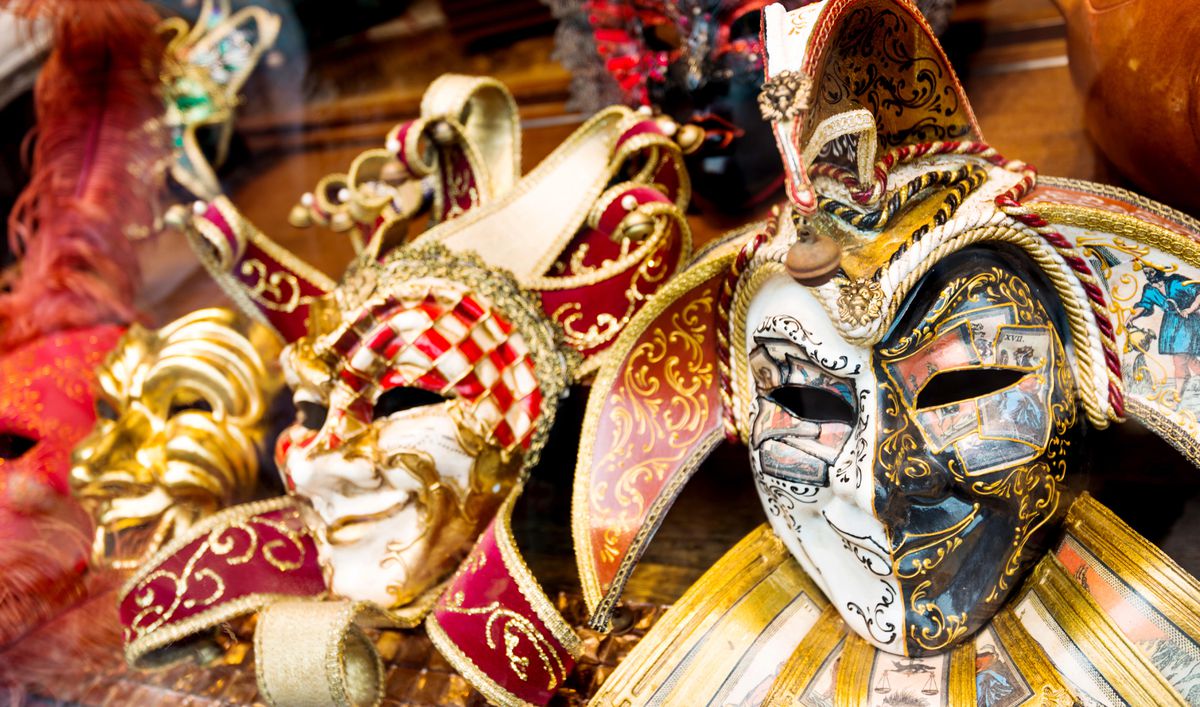
Venetian masks putting in a row
getty
Leave it to the Germans for providing the perfect word to explain the joy of Carnival: maskenfreiheit.
Maskenfreiheit is the freedom felt from wearing a mask.
Carnival masks can be traced back to 13th century Venice. From December 26th through Lent, Venetians wore masks for anonymity. People could mingle at parties without a reference to their social class or identity.
The idea of a mask is intriguing. Masks can hide a darker side of people because it can erase one’s responsibility for their actions. Stormtroopers come to mind. A mask can also bring out a more amplified, authentic, and less restrained version of one’s personality. Think of Batman, the capitalist Bruce Wayne turning into the empathetic life-saver Batman upon exiting the bat cave.
Carnival is one of the rare chances one can openly swim in maskenfreiheit. From the parent to the marketer to the student, people can leave everyday identities at home. Carnival excuses us to wear an entirely new mask, a completely new identity that we don’t own in our daily lives.
To better understand masks’ (and by extension, costumes’) unique effect and its connection to consumer behavior, we must first understand the psychology of identities.
Identity, Identity, Identity!
How do you act around our family members vs. friends vs. colleagues? How about the shift from beast-mode during early morning spin class before moving onto work-mode during nine-to-five, and jump into party-mode during the other nine-to-five on the weekend?
Social psychologists go far enough to say that individuals are a slightly different person. People dawn a unique identity with a slightly different personality, vocabulary, preferences, and behavior, depending on the context. It makes sense why brand managers are obsessed with personalities and identities.
JIF peanut butter targets mothers by claiming, “Choosy moms choose JIF.” Under Armor targets underdogs with “The only way is through.” exclaims, while Old Spice reminds men to “Smell like a man, man.” and Chevrolet never lets car buyers forget that Chevy Runs Deep (and American). The list goes on and on.
Research provides further validation of the strategy of targeting multiple identities. Consumers respond positively to brands and products which are perceived to share a common identity. For example, when you’re at the gym in beast-mode, you’ll show a preference for identity-linked brands, such as Gatorade, instead of brands that don’t share the identity like Vitamin Water. Vitamin Water may deliver you just as many electrolytes at a lower price point, but it doesn’t link to your athlete identity the same way. Gatorade speaks to the beast-mode directly; Vitamin Water doesn’t.
Back to Masks
And here’s where the everyday costumes come into play. There’s a corresponding costume for each of the roles consumers play in their daily lives (vegan, father, doctor, or Lakers fan). Investment bankers rocking a business suit to a meeting or a free-spirit in yoga pants en route to the studio – Consumers are not just putting on clothes; they are putting on the associated identity.
Uniforms create psychological transformation. Bruce Wayne enters the bat cave, and Batman exits.
A Northwestern University study shows the impact of identity on behaviors. Researchers put participants into two groups: Group A was given white doctor’s coats, and Group B, simple plain street clothes. The result – Group A, in the doctor’s coats, performed much better on tests of accuracy and attentional focus.
Why? Over time, brains created an association between doctors and a sense of intelligence and accuracy. And by wearing the uniform, the brain of participants assimilates these associative characteristics into their current behavior.
The same lesson also explains why consumers jump higher or hit the golf ball further using gear made from their favorite brand. People play better or at least have the confidence to play better when donning the jerseys or shoes made by their preferred brands. All of these “costumes” cue identities, and along with them, their unique behaviors and personalities.
Consumers continuously wear costumes and masks while switching between their everyday identities. The only difference on Carnival is the mask isn’t linked to any of the usual, everyday identities. It’s like an accountant dressing up as a clown or the head of ops dressing up as a raver. There is a rare sense of liberation behind these masks.
The Costume of a Consumer
Everyday identities are more predictable than one might think. So much so that simple aspects of identity can predict buying behavior to a shocking degree. Using machine learning to analyze their purchases, a team of researchers at the University of Chicago could predict the age, sex, race, political affiliation, age, and socioeconomic level of research participants.
For gender, this is easy – men rarely buy eyeliner, and women rarely buy men’s aftershave. Others are more surprising. For instance, the most accurate predictor of someone being white is whether they buy English Muffins. Similarly, watching The Big Bang Theory is also a key indicator of one’s Caucasian descent. Moreover, owning a fishing pole is the best predictor of being politically conservative. And the fast-food brand most closely associated with being conservative? Arby’s.
One costume everyone has in common is one of a consumer. People buy things to signal a part of their individual selves. It is up to marketers to help consumers express their identities by creating brands-as-costumes.
Happy Carnival!
This article is auto-generated by Algorithm Source: www.forbes.com


